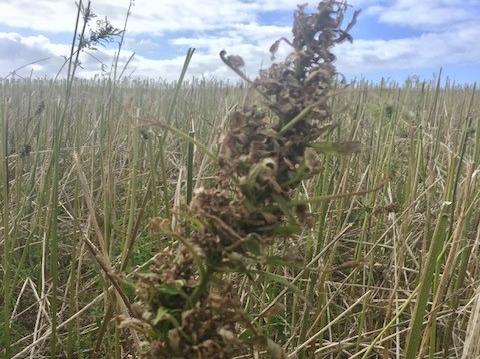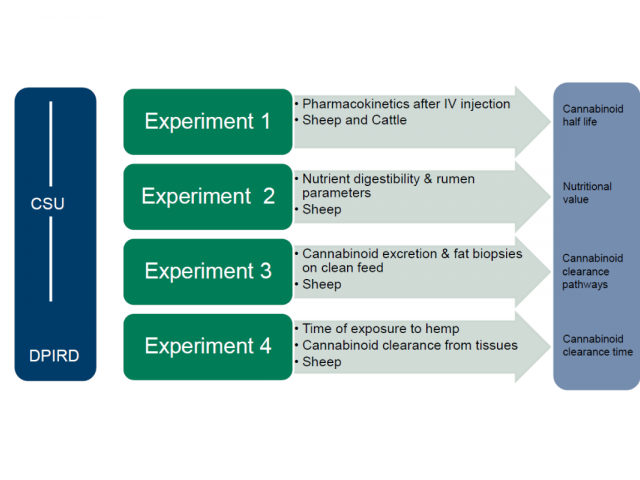Project overview
Diversifying feed options for livestock is vital to lowering on-farm risk and adapting to seasonal variability. Hemp has been identified as a high-yielding (5-15t biomass/ha, 0.6-1.2t seed/ha), multi-purpose crop and an emerging industry in Australia. Hemp, a summer crop, grows in a wide range of climates provided adequate moisture is present at sowing. Hemp has therefore been flagged as a new summer forage option for ruminants.
In Mediterranean and temperate mixed-farming systems hemp may provide green feed for ruminants in late spring/early summer. This may offer valuable green feed at the critical time of joining and for weaner growth and survival. Alternatively, the stubble may be grazed after the crop is harvested for seed/fibre.
Current regulations around feeding hemp to livestock
Whilst each State has slightly different policies, the regulations are alike at a national level. That is, it is only legal to feed hemp to food-producing animals if it is:
- harvested or treated hemp stalks with all leaves, flowering heads and seeds removed
- denatured industrial hemp seed, or
- oil extracted and meal ground from denatured industrial hemp seed.
It is not legal to feed the following to food-producing animals:
- any hemp plant that still has leaves, flowers or seeds attached
- "failed" industrial hemp crops left unharvested in a growing paddock, or
- non-denatured hemp seed.
Tetrahydrocannabinol (THC) is considered a contaminant and is not allowed to be present in supplied animal products unless Food Standards Australia and New Zealand (FSANZ) has set a safe allowed level (a ‘maximum level’) for the contaminant. FSANZ have not set a maximum level for THC in animal products due to lack of data. Therefore, the current maximum acceptable level of THC in food coming from animals is zero.
For more information read Use of industrial hemp as animal feed in Western Australia.
Project aim, objectives and outcomes
This project aims to benefit the emerging industrial hemp industry as well as the livestock and grain industries in Australia. The primary aims of this research are to:
- understand the effects of consuming hemp biomass on growth performance and carcase traits of sheep,
- measure cannabinoid excretion from sheep and accumulation in tissues.
Outcomes
- Provide initial data required for development of government regulation and recommendations for feeding hemp foliage to livestock.
- Increased adoption of industrial hemp as a new forage option for irrigated and dryland farming regions (annual rainfall above 600ml) due to stronger understanding of grazing application and effect of feeding hemp on sheep productivity, nutritional value, meat quality and food safety.
What are the benefits of this research?
Globally, food safety organisations are unable to write regulations incorporating whole-plant hemp into livestock feed regimes due to a lack of data in this field. This research is a proactive step towards assisting favourable regulations/feeding recommendations to be drafted. The research may also uncover production and/or health benefits for livestock, which may have commercial potential.
If results are favourable, the direct benefits of this research will include:
- attracting new growers to the hemp industry if regulations change to allow animals to graze hemp;
- improving crop useability and reducing risk for existing growers by creating a use for the foliage;
- providing a new summer forage option for livestock.
Project partners
Led by DPIRD, this project is operating in close partnership with ChemCentre and Charles Sturt University. AgriFutures Australia is the major project sponsor, delivered through their Emerging Industries program.
Project timeline
This project commenced in January 2020 and will finish in June 2022. There are two main phases to this project and results will be published on this page as they become available.
Phase 1
As a pilot study, the aim of this experiment was to obtain data on a wide range of parameters to guide future research. Hemp stubbles, which is the remaining biomass after seed harvest, was selected for the investigation as it is currently an unutilised byproduct in hemp production systems.

Phase 1 objectives:
- Analyse and understand nutritional value of post-seed harvest hemp biomass (stubbles) as a potential feed for ruminants.
- Measure cannabinoid excretion from sheep and accumulation in animal tissues.
- Measure animal performance and carcase traits of sheep fed diets containing hemp at varying inclusion levels.
Methods
The project objectives were met through a single experiment (Table 1) conducted at Charles Sturt University using 15 Merino wether sheep aged 12 months. The use and care of animals was approved by CSU Animal Care and Ethics Committee (Protocol number: A20016) and was compliant with the Animal Research Act 1985 (as amended) in accordance with the Australian Code of Practice for the Care and Use of Animals for Scientific Purposes.
Industrial hemp biomass (variety Morpeth Late) was grown and collected by a licensed, commercial grower in the Manjimup region of South West Western Australia. Three diets were used in this trial and included industrial hemp biomass (leaf, flowering heads, stem) at 0, 28 and 56% with oaten chaff as the substitute forage. They were formulated to be a complete ration for weaners and to be balanced in energy and protein, with the only major difference between the diets being the proportion of hemp to oaten chaff.
| Experimental Phase | Days | Measurements |
|---|---|---|
| Adaptation to diets | 0-14 | Liveweight (LW), dry matter intake (DMI), orts |
| Digestibility study | 15-21 | LW, DMI, orts, faecal & urinary output, 1 x rumen fluid sample on day 21 |
| Animal performance | 22-56 | LW, DMI, orts, 1 x blood sample on day 56 |
| Carcase traits | 56 | Hot carcase weight, cannabinoid analysis of subcutaneous fat, striploin, liver & kidney fat |
Results
Animal performance
Substitution of oaten straw with hemp stubble at two levels was not detrimental to feed intake, liveweight gain or carcase traits. In fact, there was a tendency for improved liveweight gain and further investigation is warranted. Overall, the results indicate hemp stubble to be a suitable replacement for cereal straw in pelleted rations.
Cannabinoid residues
Cannabinoids in the form of Δ9-THC and THCA were detected in all measured tissues but at extremely low levels (<300 μg/kg DM). Currently, regulations state zero tolerance for THC in animal tissues and this is what researchers and producers should work towards. The sheep in the current trial were given every opportunity to express cannabinoid residues i.e. they grew fat and were exposed to hemp for a long time (56 d). Whilst there indeed were residues, they were extremely low. This suggests there is plenty of scope to develop management practices for feeding hemp biomass to ruminants allowing their products to enter the market with zero THC. There may also be scope for FSANZ to set a maximum allowable limit for THC in animal products in the future as more data becomes available.
Recommendations
As THC residues were detected, research should now focus on advancing understanding of cannabinoid digestion and metabolism in ruminants; including half-life, excretion pathways, and clearance from subcutaneous fat, muscle, liver and kidneys. This should be investigated in both sheep and cattle, as there is no evidence to suggest cannabinoid metabolism is the same across both species. Literature and our results suggest cannabinoids are endemically accumulated in fatty tissue and deposits. These tissues tend to have a slow turnover rate, indicating a clearance period will likely be a necessary management tool for livestock receiving hemp fodder.
A copy of the full report can be found on the AgriFutures website.
Phase 2
Phase 2 of ‘Opening the gates to hemp grazed livestock in Australia’ will investigate nutritional value and THC pathways of industrial hemp during the flowering stage.
As described in Figure 1, four experiments will investigate the following:
- pharmacokinetics and excretion of cannabinoids in sheep and cattle;
- nutrient digestibility and rumen parameters in sheep;
- excretion of cannabinoids by sheep whilst on clean feed; and
- effect of exposure time on cannabinoid deposition and remobilisation from various tissues in sheep.

Phase 2 has been planned around the following objectives:
- Measure and determine cannabinoid digestion, metabolism, storage, and excretion (i.e. pharmacokinetics) in sheep and cattle, and remobilisation in sheep.
- Measure and establish the nutritional value of hemp forage as a potential green feed for ruminants in summer.
- Measure the effect of exposure time (days) on cannabinoid deposition and remobilisation in liver, kidney fat, muscle and subcutaneous fat in ruminants.
This data will provide valuable insight into the half-life of THC in sheep and cattle and the rate of elimination of THC from various tissues.
The results will contribute towards drafting an Industry Code of Practice for feeding hemp forage to ruminants.
As in Phase 1, project partners include DPIRD, ChemCentre and CSU, with AgriFutures Australia as the major sponsor and Omega Assets Pty Ltd as a minor sponsor.
Completion of Phase 2 is expected in March 2023.
Results will guide further research in this field.
